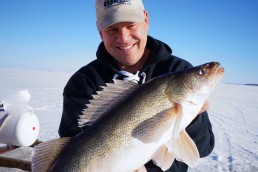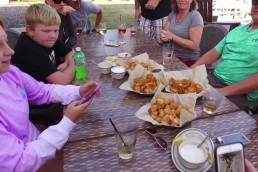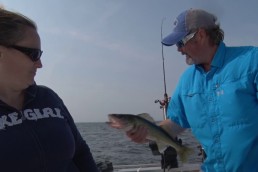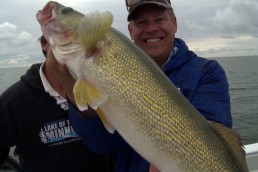Icing March Walleyes on Lake of the Woods
SHARE THIS POST
The scenario plays out each year—the days get longer, the air begins to warm and the water begins to flow. This is when the walleyes’ instincts tell them to bulk up for the spawn. March on “The Walleye Capital of the World” is when the walleyes are on the move. And it’s prime time for icing them on Lake of the Woods.
The majority of this region now can have poor ice conditions and closed walleye seasons, but on Lake of the Woods, because it’s so far north and has border waters with Canada, different rules do apply. Fish houses are allowed overnight on the ice through March and the walleye season is open until April 14. This opens up a window of fishing for this species that many wait most of the year for.
March is a great ice-fishing month in the North Country with longer days, the stronger sun angle and melting snow and ice, which oxygenates the water. The spawning season is approaching and it is time for walleyes to build energy and feed. With all of these factors, the fishing here can be very good.
There are a few spots that are absolute magnets for March ‘eyes. With Big Traverse Bay primarily made up of a muddy bottom, the scattered reefs that pop up can be go-to areas for walleyes. In addition, areas adjacent to known spawning areas can be hot.
Here are a few spots to consider for hot spots this month on Lake of the Woods.
The south shore
With increased flow and adjacent to known spawning areas, Pine Island can yield some excellent fishing. Some of the walleyes in the system are beginning to stage for the spawn up the Rainy River. These fish are setting up in the mud just outside of the Lighthouse Gap and Morris Point Gap on the south end of the lake, just adjacent to Pine Island. With increased water flows coming from the Rainy River and Bostic Creek, the walleyes start to hone in on their spawning areas. These locations can be stacked with fish. Another strong area is just to the west of Zippel Bay where it transitions to smaller rocks that attract walleyes now.
Knight and Bridges islands
This area hugs the eastern side of Big Traverse and is located 20 miles north of Wheeler’s Point, the mouth of the Rainy River. This area is loaded with a variety of reefs, gravel and mud transitions. Set up on the deep transitions, from rock to mud, at 27 to 32 feet of water. During low-light periods, walleyes will go up shallower to feed, but the deeper transitions are better bets.
Long Point to Rocky Point
Again, this section of the lake is loaded with reefs that come out of miles and miles of mud, and walleyes and saugers hang out in these reefs. This time of year jumbo perch will also show up. When the jumbos, or humpbacks, show up they’ll often exceed 13 inches.
Are you enjoying this post?
You can be among the first to get the latest info on where to go, what to use and how to use it!
The NW Angle
This area north of Garden Island is where the 14,552 islands of the lake begin. Islands, reefs and underwater points decorate the mud as the lake transitions to more of a rocky landscape. There are literally dozens of spots to fish. It’s not uncommon to hear of an evening bite on the top of a reef or in areas adjacent to moving water yielding fish after fish as these aggressive feeders take advantage of the low-light periods.
Accessing these spots
Both south end and NW Angle resorts will move houses on some of the spots mentioned. Being mobile is certainly an option as long as you have the right equipment. However, it is nice from time to time, if it’s cold enough out, to be able to drive up or get dropped off at the door of a nice fish house with the heat on and holes drilled. This is also ideal when fishing with folks who don’t have the equipment to venture out. The other option is to snowmobile or to use a collapsible fish house. There are snowmobile trails that go from the mouth of the Rainy River all the way up to the NW Angle or from Rocky Point up to the NW Angle again. These trails are marked and groomed so it’s usually easy to get around, allowing anglers or outdoors enthusiasts more access to the areas discussed.
Methods
Catching March walleyes doesn’t have to be rocket science. Typically, with the two lines per angler allowed for ice fishing in Minnesota, you can jig with one line and use a deadstick in the second hole. Jig with your favorite spoon tipped with a frozen shiner head or body. Vary your jigging motion until you get the fish dialed in that specific day. Electronics are helpful too, as they not only tell you when and where the fish are coming through, but they also help educate you on how the fish want the presentation that day.
In the deadstick hole, set a live minnow on a hook or your favorite ice jig 6 inches to 1 foot off of the bottom. Most use a bobber, though many guides will not use one, but rather set their rod on a bucket so the rod is sideways to them and they can then see the slightest movement on the tip of the rod. If that rod tip goes down at all, it’s time to set the hook. The thought is this method will pick up some fish that the bobber line would not have indicated.
With the walleyes bulking up it’s time to try your favorite swimming minnow bait like a Chubby Darter, Lindy Darter or Jigging Shad Rap. All can be effective as larger-profile baits that get a fish’s attention as it searches for larger forage.
Colors
Every year can be different; every day can be different. There are some known go-to colors that seem to stand the test of time. Gold is a staple on Lake of the Woods due to the slightly “stained” water here, which comes from the bogs releasing tannins. This stained water coaxes the walleyes to eat during the day rather than the middle of the night, which is just at the liking to most anglers with “normal” sleep patterns. Other strong colors are the glow colors (my favorite is glow red), pink and orange. Some days, the fish bite is so good that you could probably catch one on a hot dog. But when conditions are more challenging, play around with colors.
There is a lot of excitement in March as Midwesterners are looking for a reprieve from the grasp of winter. The days are longer and 40 degrees feels like a heat wave. And if you’re a walleye angler, don’t put away your ice fishing equipment just yet, as you can extend your season by grabbing some sunscreen and enjoy icing those LOW March walleyes.
MWO
SHARE THIS POST
Did you enjoy this post?
You can be among the first to get the latest info on where to go, what to use and how to use it!
Joe Henry
Tournament angler and licensed charter captain Joe Henry fishes and hunts the Midwest. Henry is a media member of AGLOW and writes for numerous publications, creates videos, appears on a variety of outdoor TV and radio shows and is a frequent seminar speaker. Henry is the Executive Director of Lake of the Woods Tourism.



